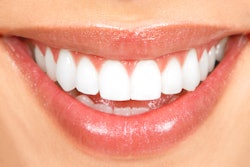
A 57-year-old, postmenopausal woman presented to her regular restorative dentist, Dr. E, whom she had seen for a number of years, and in whom she had trust and confidence. The patient, Ms. P, had lost her four upper incisors in a bicycle accident about five to seven years prior but was no longer cosmetically satisfied with the removable partial denture she had been wearing, despite the fact that she had been functioning quite well with it.
Ms. P had seen TV commercials touting the benefits of dental implants to allow for the replacement of missing teeth. She was struck by the degree to which cosmetics could be improved in situations much like hers.
 Dr. Marc Leffler.
Dr. Marc Leffler.On her updated health history form, the patient noted that her only medical issues were related to laboratory outcomes, which demonstrated a moderately elevated serum calcium level and a bone density study about three years prior to the current visit that revealed widespread osteopenia with focal areas of osteoporosis. As a result, she had been on a regular oral regimen of a bisphosphonate, prescribed by her primary care physician, since shortly after the diagnoses of osteopenia and osteoporosis were made.
After briefly discussing the patient's medical history with her, Dr. E stated that he was not concerned with her bone condition, or the medical treatment for it, especially because the last monthly oral dose had been taken 20 days earlier, and because she had suffered no associated problems during her 2 1/2 years of taking the medication. A surgical appointment was scheduled for three days later, when the patient was able to schedule some time off from work.
On the day of surgery, Ms. P was handed a consent form by a dental assistant. The patient was asked to read and sign the form. She had some questions regarding the written risks, but the assistant assured her that this form was "just for the lawyers," so she shouldn't be concerned. The assistant added that Dr. E had been placing implants for a long time and is excellent at what he does, so all of his patients do well, and there was nothing to worry about.
The patient signed the form before the doctor came into the room, and nothing was said about it or its contents after he arrived. A nitrous oxide/oxygen mixture was given through a nasal mask, followed by local anesthesia, and four carefully chosen implants were surgically placed in the sites that teeth #7, #8, #9, and #10 had occupied without the need for any bone grafting, all under copious irrigation and attention to textbooklike detail, after which the site was sutured.
The patient's partial denture was relieved of pressure points on the underlying gingiva and reinserted. Ms. P was then discharged home with prescriptions for one week of antibiotics and analgesics. She was appointed to return in a week for suture removal.
At the postop visit, the patient complained of continuous, low-grade discomfort and tenderness. Dr. E examined the area. When he removed the sutures, he noticed small shards of bone being ejected from the entire upper anterior region, which he removed, followed by irrigation. Ms. P was discharged and advised to return in four months for preparation for implant uncovering, or sooner if any problems developed, or if she had any concerns.
Two weeks later, she returned with continuing symptoms, and an increasing number of bony spicules were noted and removed, so the site was again irrigated, with a refill prescription given for antibiotics. This was followed by weekly visits, each time with increasing pain, which was repeatedly treated with the same process of irrigating and removal of small bone fragments.
Approximately three months after the implant placement, Dr. E took a radiograph for the first time postoperatively, a panoramic film, and noted areas of what looked to be bony sequestra and poorly defined radiolucencies. Unsure of what he was seeing, Dr. E referred the patient to an oral surgeon, who, that same day, took several specimens of bone from under a small flap, and sent them for pathology. A diagnosis of "osteomyelitis vs. osteonecrosis" was returned.
Given the patient's bisphosphonate history, the oral surgeon concluded that Ms. P had developed bisphosphonate-related osteonecrosis of the jaw (BRONJ) and planned a hospital admission for coordination with an infectious diseases specialist.
After admission and concurrence by the medical specialist as to the likely BRONJ diagnosis, IV antibiotics were begun, and the oral surgeon then brought the patient to the operating room for open exploration and thorough debridement of the anterior maxilla.
The amount of necrotic bone that had developed over the relatively short time was substantial. The surgeon aggressively excised the necrotic bone, which extended close to the nasal floor. All four implants were removed with the bone, as were both maxillary canine teeth.
Ultimately, with no prosthodontic device in place for the next four months, and with repeated regimens of antibiotics and antimicrobial rinses, the site healed, but with bony and soft-tissue voids that were clearly apparent. Ms. P was eventually restored with a new removable partial denture, which had a far worse cosmetic appearance and less functional ability, that included a hissing sound during speech than her initial presenting appliance.
Legal action
Ms. P's retained attorney obtained the dental and hospital records and had an expert review them. A lawsuit was then instituted against Dr. E alleging negligence and lack of informed consent.
The major claims of negligence were improper patient selection, the failure to consider and protect against the well-known effects of bisphosphonates, the failure to coordinate care with the patient's primary care physician, and the failure to timely diagnose and act on the bony destructive process postoperatively, thereby leading to the loss of bone and teeth to the point that she could no longer adequately function and that a prominent area of her facial appearance was cosmetically unacceptable.
Case defense steps
Defense counsel obtained an expert who was a board-certified oral surgeon with much experience placing implants.
The expert was critical of the approach taken by Dr. E for numerous reasons:
- Most particularly, the expert was critical of Dr. E regarding the selection of a patient for implants who, because of using a bisphosphonate, was at high risk for BRONJ.
- Furthermore, while prescribing antibiotics was considered appropriate, delaying the first taking of a radiograph for three months, especially in the face of ongoing problems, and not referring Ms. P to an oral surgeon early in the compilation phase were viewed by the expert as outside the standard of care.
- Finally, the expert was critical of the fact that, prior to agreeing to perform this elective surgical procedure on this patient, Dr. E should have recognized the significance of the patient's medication regimen and involved the patient's primary care physician in the decision-making process by obtaining medical clearance.
In the lead-up to trial, counsel for the plaintiff and defendant engaged in a court-ordered settlement conference, which led to an understanding regarding an appropriate settlement value, but was subject to the agreement of Dr. E, whose dental malpractice policy allowed him the option of refusing a settlement in favor of going to trial. Only upon Dr. E's agreement to settle were those terms accepted, thereby ending the case.
Takeaways
The concept of obtaining medical clearance from a patient's physician is a judgment determination, but it ought to be considered when a patient presents with medical conditions, medication regimens, and/or social habits that the practitioner is either concerned about or unfamiliar with.
If a dentist does consult with a physician, best practices dictate that the substance of the interaction be documented, preferably with a writing directly from the physician consultant, but minimally with a detailed, contemporaneous chart entry. In the event of subsequent litigation based on a medical issue, such documentation will provide defense counsel with strong evidence of the dentist having taken appropriate steps.
Patient selection criteria, based on every patient parameter available, are paramount to a successful result and a satisfied patient. Here, the patient's bisphosphonate regimen was an important, even critical, factor in that selection process. Not every patient can have every procedure.
It is not the purpose of this case study to advise as to what treatments are appropriate, as that is left to the practitioner's judgment. But certain concepts -- such as developing differential diagnoses when problems arise, ongoing determinations as to when to use radiographs, and when to make referrals -- are best considered thoroughly with all patient interactions.
When patients present for any cosmetic concern, dentists should recognize that cosmetics are subjective in nature, and might be viewed differently by patients and dentists, so there is an increased risk of patient dissatisfaction -- or claimed dissatisfaction -- when procedures are performed primarily for aesthetic reasons, as compared with those performed purely for functional improvement.
When obtaining a patient's informed consent, dentists should understand that this is not satisfied simply by receiving a signed piece of paper, regardless of how much detail that form contains. Consent is a give-and-take process between doctor and patient in language and terms understood by the patient in which the patient is advised of the benefits of, alternatives to, and the foreseeable risks associated with the planned procedure and its viable alternatives. The process must be specific to the procedure and the individual patient, taking into account that patient's medical, surgical, and social history.
When practitioners discuss risks not included on preprinted forms, those should be documented in the chart. Obtaining informed consent is generally not delegable to a person other than the practitioner about to perform the procedure, although in some limited situations, a similarly trained practitioner who knows the case-specific facts may stand in for that purpose, but a dental assistant or other nonprofessional staff member is incapable of playing that role, as this case clearly demonstrates.
In a similar vein, it is all too common for nonprofessional office staff to render opinions, give advice, or otherwise comment on treatment-related issues. Practitioners must realize that they are liable for any and all consequences that may arise from the actions/inactions of their staff members. Staff training is necessary to make the members aware that they must not provide any such information or recommendations to patients, other than for entirely administrative purposes.
This concept holds, as well, for telephone interactions between the patient and office staff when the practitioner is rarely present and when patients frequently ask questions about their care or condition. Such inquiries must be directed to the practitioner.
As this case demonstrates, a dentist's specifically stated grant of approval to a nondentist to handle the obtaining of informed consent, or any other procedure not directly allowable under state law, does not make it permissible, and, further, sets the dentist up for liability for actions by staff.
Finally, it is impossible to know what will ultimately lead to case resolutions, but when insurance carriers retain defense counsel who are experienced and aware of all available approaches, dentists and other professionals are best protected. And when practitioners' liability policies allow them to decide whether or not to settle, they control their own destinies.
Dr. Marc R. Leffler is an oral and maxillofacial surgery and dental consultant for MedPro Group. He received his dental degree from Columbia University, completed a residency in oral and maxillofacial surgery at New York University, and is a diplomate of the American Board of Oral and Maxillofacial Surgery. The opinions expressed in this post are the opinions of the individual author and may not reflect the opinions of MedPro Group or any of its employees.
Disclaimer: Nothing contained in this column constitutes legal or medical advice and should not be construed as rules or establishing a standard of care. Because the facts applicable to your situation may vary, or the laws applicable in your jurisdiction may differ, please contact your attorney or other professional advisers if you have any questions related to your legal or medical obligations or rights, state or federal laws, contract interpretation, or other legal questions.
The comments and observations expressed herein do not necessarily reflect the opinions of DrBicuspid.com, nor should they be construed as an endorsement or admonishment of any particular idea, vendor, or organization.



















